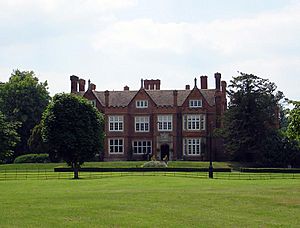Robert Edwards (physiologist) facts for kids
Quick facts for kids
Sir Robert Edwards
|
|
|---|---|
 |
|
| Born |
Robert Geoffrey Edwards
27 September 1925 Batley, England
|
| Died | 10 April 2013 (aged 87) near Cambridge, England
|
| Alma mater |
|
| Known for | Pioneering in-vitro fertilisation |
| Spouse(s) |
Ruth Fowler
(m. 1959) |
| Awards |
|
| Scientific career | |
| Fields |
|
| Institutions |
|
| Thesis | The experimental induction of heteroploidy in the mouse (1955) |
| Doctoral advisor | R. A. Beatty C. H. Waddington |
| Doctoral students | Richard Gardner (embryologist) Martin Hume Johnson Roger Gosden Azim Surani |
Sir Robert Geoffrey Edwards CBE FRS MAE (27 September 1925 – 10 April 2013) was a British physiologist and pioneer in reproductive medicine. Along with obstetrician and gynaecologist Patrick Steptoe and nurse Jean Purdy, Edwards oversaw the birth of the world's first 'test-tube baby' Louise Brown on 25 July 1978. They founded the first programme for infertile patients and trained other scientists in their techniques. Edwards was the founding editor-in-chief of Human Reproduction in 1986. In 2010, he was awarded the Nobel Prize in Physiology or Medicine "for the development of in vitro fertilization".
Contents
Education and early career
Edwards was born in Batley, Yorkshire, and attended Manchester Central High School on Whitworth Street in central Manchester, after which he served in the British Army, and then completed his undergraduate studies in biology, graduating with an Ordinary degree at Bangor University. He studied at the Institute of Animal Genetics and Embryology at the University of Edinburgh, where he was awarded a PhD in 1955 under the supervision of R.A. Beatty, and C. H. Waddington.
Career and research
After a year as a postdoctoral research fellow at the California Institute of Technology he joined the scientific staff of the National Institute for Medical Research at Mill Hill. After a further year at the University of Glasgow, in 1963 he moved to the University of Cambridge as Ford Foundation Research Fellow at the Department of Physiology, and a member of Churchill College, Cambridge. He was appointed Reader in physiology in 1969.
Human fertilisation
Circa 1960 Edwards started to study human fertilisation, and he continued his work at Cambridge, laying the groundwork for his later success. In 1968 he was able to achieve fertilisation of a human egg in the laboratory and started to collaborate with Patrick Steptoe, a gynaecological surgeon from Oldham. Edwards developed human culture media to allow the fertilisation and early embryo culture, while Steptoe used laparoscopy to recover ovocytes from patients with tubal infertility. Their attempts met significant hostility and opposition, including a refusal of the Medical Research Council to fund their research and a number of lawsuits. Roger Gosden was one of his first graduate students.
The birth of Louise Brown, the world's first 'test-tube baby', at 11:47 pm on 25 July 1978 at the Oldham General Hospital made medical history: this meant a new way to help infertile couples who formerly had no possibility of having a baby. Nurse Jean Purdy was the first to see Brown's embryo dividing.
Refinements in technology have increased pregnancy rates and it is estimated that in 2010 about 4 million 'test-tube babies' have been born.
Edwards and Steptoe founded the Bourn Hall Clinic as a place to advance their work and train new specialists. Steptoe died in 1988. Edwards continued on in his career as a scientist and an editor of medical journals.
Honours and awards
Edwards received numerous honours and awards including:
- Edwards was elected as a Fellow of the Royal Society (FRS) in 1984.
- In 1994, Doctor Honoris Causa, University of Valencia (Spain).
- In 2001, he was awarded the Albert Lasker Clinical Medical Research Award by the Lasker Foundation "for the development of in vitro fertilization, a technological advance that has revolutionized the treatment of human infertility."
- In 2002, he was awarded Grand Hamdan International Award - Obstetrics & Gynecology by Hamdan Medical Award.
- In 2007, he was ranked 26th in The Daily Telegraph's list of 100 greatest living geniuses.
- In 2007, he was awarded an honorary doctorate from the University of Huddersfield.
- On 4 October 2010, it was announced that Edwards had been awarded the 2010 Nobel Prize in Physiology or Medicine for the development of in-vitro fertilisation.
- Edwards was knighted in the 2011 Birthday Honours for services to human reproductive biology.
- Edwards featured in the BBC Radio 4 series The New Elizabethans to mark the diamond Jubilee of Queen Elizabeth II in 2012. A panel of seven academics, journalists and historians named him among the group of people in the UK "whose actions during the reign of Elizabeth II have had a significant impact on lives in these islands and given the age its character".
Personal life
Edwards married Ruth Fowler Edwards (1930–2013), also a scientist with significant work, granddaughter of 1908 Nobel laureate physicist Ernest Rutherford and daughter of physicist Ralph Fowler, in 1956. The couple had five daughters and 12 grandchildren.
Death
Edwards died at home near Cambridge, England on 10 April 2013 after a long lung illness.
A plaque was unveiled at the Bourn Hall Clinic in July 2013 by Louise Brown and Alastair MacDonald – the world's first 'test-tube' baby boy – commemorating Steptoe and Edwards.
See also
 In Spanish: Robert Edwards para niños
In Spanish: Robert Edwards para niños


